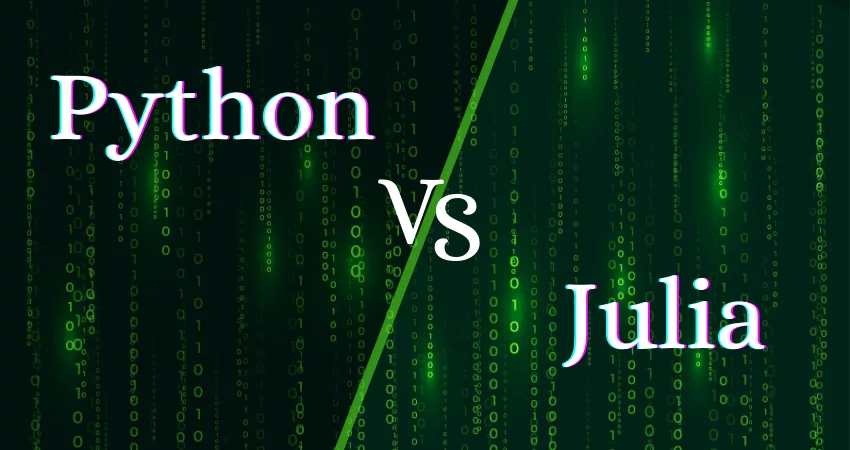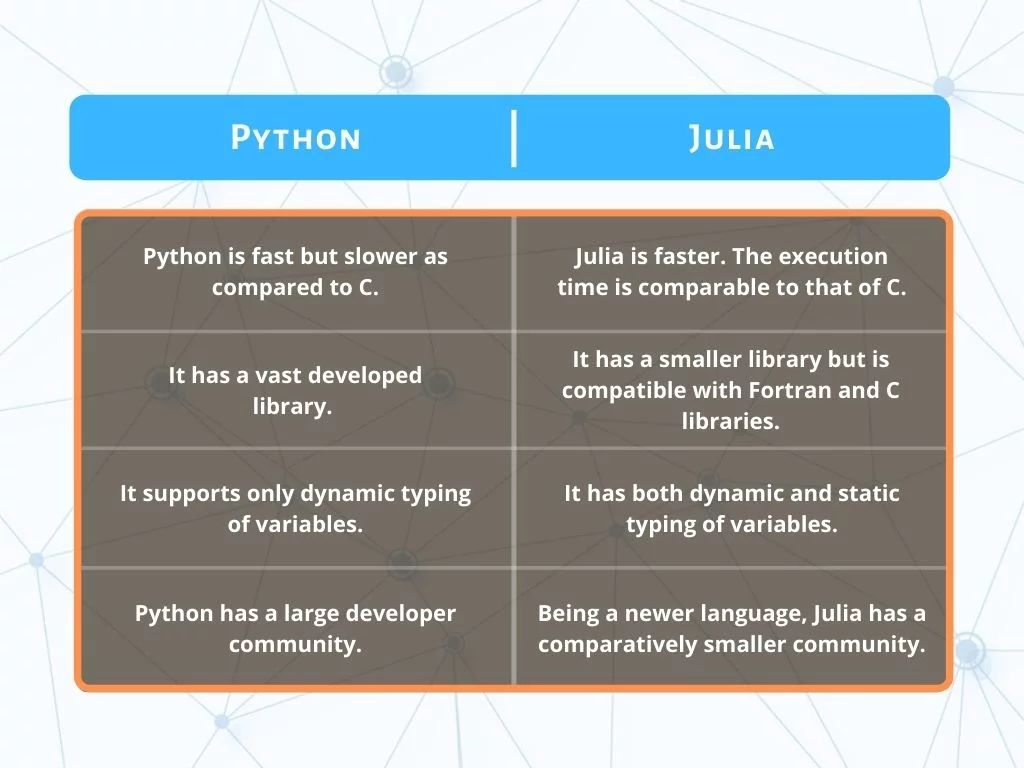Programmers are always on the lookout for languages that are fast and easy to use. Most importantly, it should be loaded with features that allow them to develop complex applications with ease.
To date, Python was carrying the torch of programming languages as the leading language. Though it still maintains its numero uno spot, a new competitor has emerged from MIT’s development labs i.e. Julia.
Julia was developed and unveiled in 2012. The aim was to match the flexibility of Python and speed of C to create the ultimate programming language.
After the official debut in 2018, Julia rose to the programming scene like a storm. All these years, purists who swore by Python had a sudden change of heart when they witnessed what Julia could do.
So the ultimate question arises – Julia or Python; which is better and what are the differences between the two?
If you pitch Python and Julia against each other in a standoff, it will make for an interesting battle.
They have significant differences between them across parameters. Most importantly, Julia is the faster programming language among the two.
The Python community has reacted by bringing in tweaks and updates to make Python comparatively faster. But when it comes to the Vanilla Python, it does not match Julia.
The one place where Python does score over Julia is the community. Python being a veteran software development language, has the support of a broad community.
They are continually working towards developing Python into a stronger entity every day. Moreover, Python also has vast library support. This makes it quite versatile to use.
However, Julia is also catching up with its community, albeit small, by developing an extensive library.
An added advantage for Julia is the capability to leverage C and Fortran libraries as well.
Julia’s package manager is also a breeze to use. Its Pkg manager is a whole level above Python’s Pip. It enables developers to build, add, remove packages, and a lot more.
Pkg being tied up with Git is an added advantage. Adding and updating packages is made easy with this.
Julia provides the advantage of static and dynamic typing.
Julia’s parallelization is better in comparison to Python as well as it has less top-heavy syntax. It thus makes the threshold smaller in comparison.
When it comes to outright performance, Python is nowhere near to match Julia.
The Python community has released multiple patches and updates to bridge the gap to a certain extent.
Yet, Python has not been able to reach the performance level of Julia. Julia is faster and can handle complex statistics and AI/ML program development with ease.
Julia has a direct compiler and does not need an interpreter. This eliminates the extra step and hence compiles quicker and at a near run-time.
Also Read: Machine Learning and Deep Learning – Know the Difference
Python is more popular than Julia today owing to its widespread applications and a humongous developer community.
Julia is catching up by leaps and bounds, though. It might not be a bad idea to put your money on Julia surpassing Python much sooner than one might have expected.
Julia is continually working on adding more libraries as well as improve its compatibility with many third-party libraries.
This is expected to boost its capabilities even further and also help the coders develop code faster.
Overall, being the new kid on the block, Julia has gained more popularity than any other programming language in this stage of their life cycle.
This is definite proof of what more is to come from the MIT team developed programming language.
This is a question that has the entire developer community split by opinion.
The trend graph shows that Python is clearly the more popular of the programming languages.
Then again, it has a substantial advantage of being a veteran in the programming language world. Considering that Julia is still new, it will take some time for it to gain traction overall.
These numbers are in no way the actual depiction of Python against Julia. Julia has already received many takers among the enterprise community.
It is only a matter of time that Julia catches up with Python and gives it a tough fight for the number one spot.
Some swear by Python as being the undisputed leader among programming languages.
On the other hand, Julia is garnering more fans every day. Some developers who have given Julia a try have also praised it highly.
So the question then can only be answered by comparing the two across various parameters.
We have seen that Julia is faster than Python, and its capability to leverage C and Fortran libraries adds to its versatility.
Then there is more, multiple dispatches in Julia is quick. Its polymorphic dispatch enables functions to be applied as properties, making it extendable.
The main reason why Julia is being pegged to pip Python’s crown is that it is made for Machine Learning (ML).
The main reason why the creators of Julia created it was to enable quick and easy development of machine learning and artificial intelligence (AI) applications.
Programming for statistics and mathematics is a strong suit for Julia, making it better than Python.
As we just mentioned above, Julia was built for statistics and machine learning.
The world is currently gripped with AI and ML. Currently, developers have been using Python, C, R, etc. to create AI/ML applications.
This is a tough ask since the programming languages have their challenges and capability ceilings.
Developing complex programs and applications need thousands of lines of extra code.
Python does a decent job at it, which is why it is widely used to date.
Julia, though, can handle complex mathematical and statistical programming with ease. It is Julia’s strong suit, providing it a one-up on Python.
This enables programmers to develop complex AI/ML applications with ease.
They can also leverage this to create even more complex applications and algorithms, which further accentuates the programs’ capabilities.
We can safely conclude that Julia, being created for the world of machine learning, clearly has the upper hand over Python.
The statistical programming capability in Julia gives it the advantage over Python when it comes to developing data science applications.
The key here is Julia’s ability to program complex mathematical operations as if you were solving it manually.
The syntax is the same and does not need any complex formulae coding. It allows the scientific community to code with ease and derives quick results.
Python even though being more user-friendly, it still cannot match with Julia in this regards.
Conclusion
Yes, Python has been around for a long time, and it has a vast user base, but Julia has the potential to be the next big thing.
It is only a matter of time that organizations and developers worldwide begin making the switch from Python to Julia.
Some developers might also go the hybrid way by opting for both Python and Julia for their coding requirements.
You can choose based on what works for you better at the end of the day.
You May Also Like to Read:
PyPy vs. Cython: Difference Between The Two Explained



